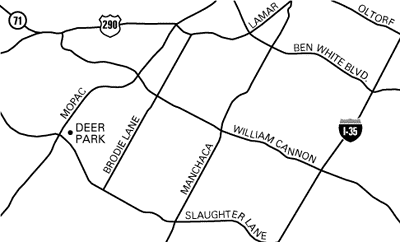Who's the Boss?
Deer Park Neighbors and Developer Vie for Control
By Mike Clark-Madison, Fri., Sept. 26, 1997
|
|
You're driving down MoPac, down way south past William Cannon. You're stuck in traffic (of course). You see a bunch of Kaufman and Broad's trademark white-on-black signs trumpeting the splendors of "their" Deer Park development. And so you follow them into an unfinished, but nonetheless quite built-out, subdivision with strangely named streets, which you deduce are the names of exotic species of deer. And there you find a bunch more K&B signs, and amidst them smaller, more vernacular signs urging you to tune into 90.1 FM on your car radio. And when you do, you hear a pleasant professional radio voice, backed by pleasant professional radio music, telling you things like: "If you're a prospective Kaufman and Broad home buyer... you should inquire about the following issues before investing your hard-earned money.... How does this builder provide `more square footage for the money?' Is this company cutting corners?"
Eventually, the radio tells you that "the majority of Deer Park homeowners are in active opposition to the sale of remaining lots to builder Kaufman and Broad of California." But you've already figured that out, because there are "No K&B" signs in damn near every yard, and sometimes picketers, and a lot of angst around the K&B sales trailer. Welcome to a good old-fashioned Austin neighborhood brawl.
Now, many Austinites, who remember when this slab of the Southwest was naught but countryside -- that is, about five years ago -- aren't much moved by the grievances of homeowners in subdivisions built out in Aquifer Country. But the Deer Park War -- waged in the streets, in the media, and in court -- turns on questions relevant to all sectors of town: What, exactly, is a neighborhood? When does it become a neighborhood? And when does the neighborhood's vision become the guiding one for future development? Kaufman and Broad is just the latest in a long, sad line of developers to find out that, in Austin, one blows the neighbors off at one's own peril.
High Volume, Low Cost
While the questions are common ones, the specifics on the ground in Deer Park are unusual and thus mighty complicated, which is what has brought the two sides to an October 13 court date. Kaufman and Broad, one of America's largest homebuilders, is as ubiquitous in California as Bill Milburn has been here. In 1995, K&B broke into the Texas market by buying San Antonio-based Rayco, corporate child of builder Ray Ellison and equally as ubiquitous there, having brought to market as much as 40% of the Alamo City's postwar housing stock, by some estimates.
Both K&B and Rayco have made their millions by turning out high-volume, low-cost-utility housing for the "more for the money" end of the home market, which is fine if you own one, but often not fine if you own the house next door, which brings us back to Deer Park. Most of K&B's current projects in Austin -- about a dozen by year's end -- are standard-issue subdivisions, brought from raw land to market by K&B exclusively. In Deer Park, however, K&B is only building 42 homes, alongside and in between 95 existing homes built by three other firms -- Wilshire, Buffington, and Plantation -- and developed by Taylor Duncan Interests, a three-man partnership that sold out to K&B this past spring.
This proved to be an inopportune juncture, falling within a gray area of the various deed restrictions, covenants, rules, regulations, and bylaws that attend to Deer Park and developments like it. To simplify (and to avoid, as much as possible, wading into legal issues that will be decided next month in their proper venue), there is a point in the life of a new subdivision when it stops being a "project" of a developer and becomes a bona fide neighborhood.
Before that point, the developer ultimately calls all the shots and can decide what gets built where. After that point, the developer leaves; the homeowners' association takes over and, through instruments like an architectural control committee, can set and enforce building and compatibility standards on future construction. In K&B's view, this point is yet to come; in the neighbors' view, that point has already happened. Both sides claim to be supported by the language of the legal paper involved, which of course did not anticipate the current circumstances of Deer Park. Which led to the creation of an alternate homeowners' association, a lawsuit filed against K&B in May, a counter-suit filed by K&B in August, and a consolidated court date for both in October.
A Jab at Prefab
|
|
Regardless of what the legal paper says, most lay observers would need some convincing before agreeing with Kaufman and Broad that their control of one-third of Deer Park gives them veto power over the owners of the other two-thirds. At this point, the incumbent homeowners seem willing to settle for nothing less than K&B's hitting the highway and taking their unfinished houses with them.
The overarching fear of Deer Park is that K&B's lower-priced -- and in the current residents' view lower-quality -- homes will erode their investment, a complaint heard often throughout the hinterlands and widely mocked in the central city, even though many in-town neighborhoods have fought all the way to Council chambers on similar grounds. "We keep hearing that this is an `upscale' neighborhood that's upset over the wrong element coming in, and that's just rubbish," says Nancy Katapodis Hicks, one of the new NA's board members. "We have nothing against first-time homeowners, because we are first-time homeowners. And it's not right -- even if it does turn out to be legal -- to walk in and tell us to hand over our equity."
Rightly or not, both K&B and Rayco have encountered this kind of opposition before; a Wall Street Journal article in 1996 alludes to the belief that "`no-frills'... translates into shoddy quality and an inferior product that drags down home values when Rayco moves into an area." Deer Park residents see this concern writ large in the K&B construction going on in their midst. "Prospective K&B buyers are being told that we're just pissed off because we paid too much for our houses," says David McNair, who sits on both the "official" NA board -- dominated by K&B reps -- and the alternate board. "But we're not sure the houses being built here are even worth what they're being sold for." (It should be noted that McNair is the Austin Chronicle's circulation manager.)
In Deer Park's view, as the radio script suggests, K&B is able to offer "more square foot for the money" by cutting corners and doing shoddy work. The price difference between the existing homes -- estimated at about $65/square foot -- and K&B's work, which comes in at less than $60/square foot, sometimes much less, is explained by K&B as an economy of scale. "When we can buy Sheetrock from the factory by the trainload, we pay less than a local builder does at a lumberyard," says K&B vice-president Kent Hicks.
But it's also evident that K&B has made choices about materials and techniques that lead to lower costs, and these have inflamed the Deer Park neighbors. Among many, many differences pointed to by the neighbors are these: The K&B homes use composite lumber for the main structural members -- i.e., waferboard, held together by glue; the walls are prefabricated and tilted up on site; vinyl siding is prevalent, covering gables and bay windows and chimneys that are likewise prefabricated and pasted on; and the attention to detail on the exteriors is fairly minimal.
On the inside, eight-foot ceilings are standard, the interiors are painted a uniform flat white, and the cabinetry and interior doors are "comparable to what's found in trailer homes," says Jamie Wise, an architect and McNair's wife. (K&B traces its roots back to manufactured housing developments in the postwar years.) The landscaping package consists of sod, as opposed to the trees, shrubs, and mulched beds that came with the existing Deer Park homes. The overall effect, says Wise, is "one half-step above base housing."
Some of these distinctions between K&B houses and the existing Deer Park homes are of debatable meaning -- after all, they simply don't build 'em like they used to, anywhere -- and some require connoisseurship to really notice. But most of the above points are plain to see, and the overall effect is palpable: K&B's prices match the specifications of the homes it's building, and its buyers are getting not more value for the money, but exactly what they paid for. This hacks off the Deer Park neighbors, who feel that the neighborhood should be built out at the same quality as currently exists, even if that means a higher cost, and that a homeowners' association and architectural controls are meant to ensure exactly that. "Kaufman and Broad act like kids getting away with something," says Wise. "It's the pillage-and-plunder approach. They could have worked with us, but their approach was bad right off the bat."
Spitting Mad
|
|
By the time K&B actually got on the ground in Deer Park, they were already in a PR hole, as neighbors traveled to other K&B developments and reported their horrified perceptions. The firm's first official communication with neighbors was a threat of legal action against those with "No K&B" yard signs (prohibited by deed restrictions). This was later withdrawn, but K&B has continued along the same lines, writing off the protesters as a tiny faction of rabble-rousers and standing by the quality of -- and need for -- its product.
Kaufman and Broad's attitude toward the protests is best summarized by its countersuit against the homeowners, which basically charges run-of-the-mill harassment -- spitting on salespeople, picketers blocking the streets, K&B signs being defaced. (In August, K&B sought restraining orders against six residents, all of which were denied.) Naturally, the company is more comfortable talking about its own conduct. "We're not here to do anything but the right thing," says Kent Hicks. "We support homeowners' associations and have in every development we've ever built. We think they're essential to the integrity and vitality of our developments. In Deer Park, we're simply following the deed restrictions that were already in place before we came on the scene."
Hicks claims that the asking prices for existing homes in Deer Park had declined before K&B even got to Austin, buttressing the company's contention that the original homes were overvalued. "We came to Austin because we felt homeowners deserved a better value, and we've sold more than 300 homes here because we delivered," he says. "Ultimately, we feel the neighborhood is asking us to build smaller houses and charge more for them, because that's what they got. We can't be responsible for what they paid."
Conforming to the demands of the neighbors would effectively destroy this raison d'etre, so the opportunity for compromise is narrow indeed -- out of a list of more than a dozen conditions submitted by the neighbors, K&B was able to agree to only two. This does not appear to concern K&B -- "We've seen similar circumstances in San Antonio," says Hicks, "and when the truth came to light, the neighborhood went on TV to apologize to us."
Don't hold your breath for this to happen in Deer Park, even if K&B does triumph -- after all, the neighbors' suit seeks confirmation of their right, through control of the homeowners' association, to tear down all of K&B's homes in the neighborhood. "At this point," says one Deer Park resident (not a named party to either suit), "we're ready to set up our chairs, pass the champagne, and watch the wrecking ball."
Got something to say on the subject? Send a letter to the editor.











